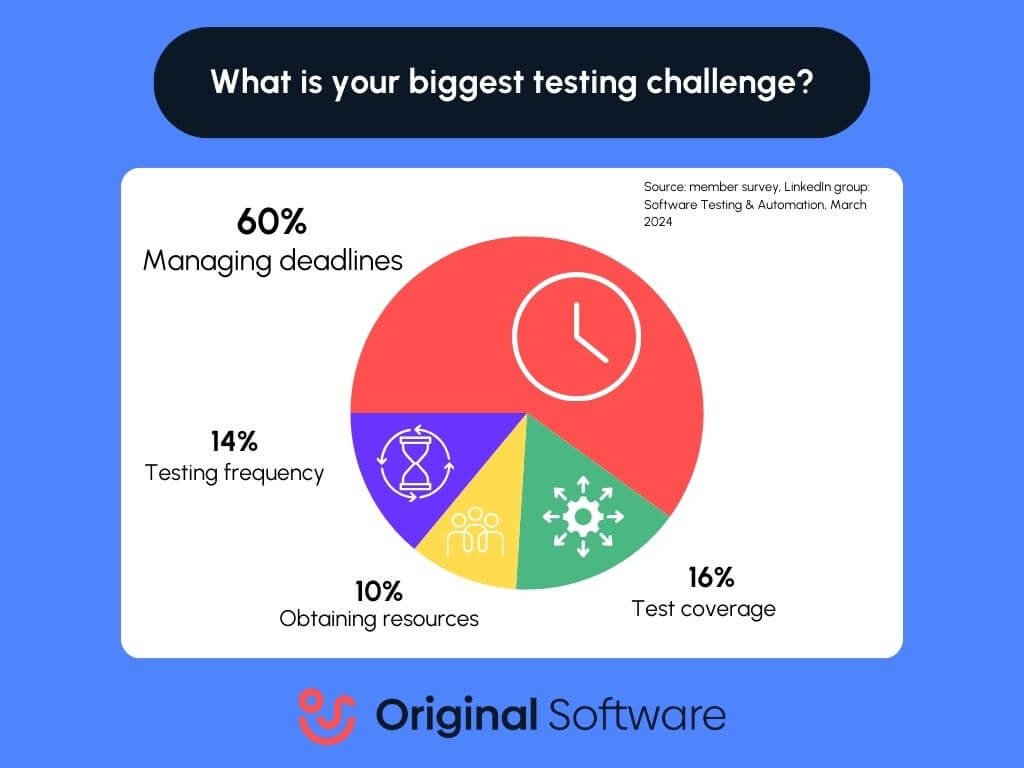Time flies when you’re having fun, they say. But they always forget to mention that time flies even faster when you’re trying to get all your software testing done before a deadline.
If you’ve ever felt the pressure of trying to get all your test cases built and out to business users ahead of a software update deadline, you’re not alone – a recent poll concluded that test managers everywhere are struggling with the same problem. In this blog, we’re diving into the time challenge in testing and suggesting how you can leave the tension of the ticking clock behind.
Time constraints are the biggest testing challenge. Building test cases takes the most time

Inspired by our recent polling efforts at MUGA conference in the US, we ran a LinkedIn poll to learn more about what challenges people face when it comes to testing. We were blown away to receive nearly 500 responses – with 60% of them saying that time and deadlines were their biggest challenge.
With that in mind, the next logical question is “what is taking the most time?”. Our data from MUGA reveals that the most time-consuming activity in testing is building new test cases, with nearly half our respondents rating it their most time-consuming activity.
It makes sense. After all, building new test cases can be a very long-winded process:
- First you have to identify the process you need to test. Given how many applications integrate with each other, the volume of processes affected by one software update could be much larger than you expect.
- Next you need to identify and document the steps for each test – possibly by shadowing a business user.
- Before your business user can conduct the test, though, you may need to prepare test data.
- Then the user needs to conduct the test itself, either by using manual testing software if you have some, or by using your new software in a dev environment.
Don’t forget, of course, that if the process changes due to a software update or to the business changing the process, your test case will have to be rebuilt. Worst of all, if you work this way then the only way you can be 100% confident that your test case works is to use it for real. If there are any issues with the test case itself, you’ve got to go back a few steps – or start again – to fix it. All of which can put your deadlines in jeopardy.
What’s the secret to easing the pressure?

Another bit of data we got at MUGA tells us that four fifths of testing professionals either have no specialized tools to manage testing, or no formal process for testing at all. If creating and managing test cases is taking up all your time, our experience says that this is the place to start. To demonstrate what we mean, here’s a comparison of the process we outlined above and that same process, supported by the right software.
- A testing platform such as Original Software can record a business user as they go about their work, making it easier to identify the processes you need to test.
- Because the processes have been recorded, converting them into manual test cases is quicker.
- With specialist software for conducting the test itself, testing is smoother and faster – and feedback is gathered more consistently.
- The work of updating test cases if the software or the process changes is made faster, too.
Part of the value is that, by using tools dedicated to manual testing, you can build test cases much faster, and be confident that they are right before you give them to your business users because they’re based on the actual work the user has done. The other part of the value in using a platform like ours is that your test cases aren’t built in isolation. Once they’re built and on the platform, you can track the tests that business users are performing, even looking at their specific feedback in just a few clicks rather than searching through emails and spreadsheets. That means you can save even more time in a bunch of places throughout the testing process:
- Business users are more likely to complete tests faster as the experience is much more enjoyable for them.
- Because feedback is given more consistently and clearly using purpose-built tools, you spend less time asking users to replicate problems or clarifying feedback for confused developers.
- Converting manual tests to automated ones (where appropriate) is faster because all the data is stored in one platform.
- You eliminate time spent rooting through your inbox or spreadsheets to work out the progress of your testing – it’s all displayed in the platform.
We know that, using our platform, companies have managed to reduce their testing times by 50%, by 75%, and even by an astonishing 95%. And we’d love to help you achieve the same results. Click here to learn more about our platform, and to get in touch to discuss where your testing time challenges are and how we can solve them together.











